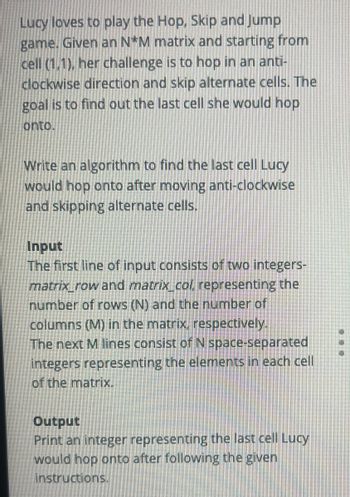
C++ Programming: From Problem Analysis to Program Design
8th Edition
ISBN: 9781337102087
Author: D. S. Malik
Publisher: Cengage Learning
expand_more
expand_more
format_list_bulleted
Question
In python

Transcribed Image Text:Lucy loves to play the Hop, Skip and Jump
game. Given an N*M matrix and starting from
cell (1,1), her challenge is to hop in an anti-
clockwise direction and skip alternate cells. The
goal is to find out the last cell she would hop
onto.
Write an algorithm to find the last cell Lucy
would hop onto after moving anti-clockwise
and skipping alternate cells.
Input
The first line of input consists of two integers-
matrix row and matrix col, representing the
number of rows (N) and the number of
columns (M) in the matrix, respectively.
The next M lines consist of N space-separated
integers representing the elements in each cell
of the matrix.
Output
Print an integer representing the last cell Lucy
would hop onto after following the given
instructions.
Expert Solution
This question has been solved!
Explore an expertly crafted, step-by-step solution for a thorough understanding of key concepts.
Step by stepSolved in 2 steps with 1 images

Knowledge Booster
Similar questions
- (Practice) Write a C++ program that adds equivalent elements of the two-dimensional arrays named first and second. Both arrays should have two rows and three columns. For example, element [1][2] of the resulting array should be the sum of first [1][2]andsecond[1][2]. The first and second arrays should be initialized as follows: first second 16 18 23 24 52 77 54 9111 16 19 59arrow_forwardThe implementation of a queue in an array, as given in this chapter, uses the variable count to determine whether the queue is empty or full. You can also use the variable count to return the number of elements in the queue. On the other hand, class linkedQueueType does not use such a variable to keep track of the number of elements in the queue. Redefine the class linkedQueueType by adding the variable count to keep track of the number of elements in the queue. Modify the definitions of the functions addQueue and deleteQueue as necessary. Add the function queueCount to return the number of elements in the queue. Also, write a program to test various operations of the class you defined.arrow_forward
Recommended textbooks for you
 C++ Programming: From Problem Analysis to Program...Computer ScienceISBN:9781337102087Author:D. S. MalikPublisher:Cengage LearningProgramming Logic & Design ComprehensiveComputer ScienceISBN:9781337669405Author:FARRELLPublisher:Cengage
C++ Programming: From Problem Analysis to Program...Computer ScienceISBN:9781337102087Author:D. S. MalikPublisher:Cengage LearningProgramming Logic & Design ComprehensiveComputer ScienceISBN:9781337669405Author:FARRELLPublisher:Cengage C++ for Engineers and ScientistsComputer ScienceISBN:9781133187844Author:Bronson, Gary J.Publisher:Course Technology Ptr
C++ for Engineers and ScientistsComputer ScienceISBN:9781133187844Author:Bronson, Gary J.Publisher:Course Technology Ptr Operations Research : Applications and AlgorithmsComputer ScienceISBN:9780534380588Author:Wayne L. WinstonPublisher:Brooks Cole
Operations Research : Applications and AlgorithmsComputer ScienceISBN:9780534380588Author:Wayne L. WinstonPublisher:Brooks Cole EBK JAVA PROGRAMMINGComputer ScienceISBN:9781337671385Author:FARRELLPublisher:CENGAGE LEARNING - CONSIGNMENT
EBK JAVA PROGRAMMINGComputer ScienceISBN:9781337671385Author:FARRELLPublisher:CENGAGE LEARNING - CONSIGNMENT Programming with Microsoft Visual Basic 2017Computer ScienceISBN:9781337102124Author:Diane ZakPublisher:Cengage Learning
Programming with Microsoft Visual Basic 2017Computer ScienceISBN:9781337102124Author:Diane ZakPublisher:Cengage Learning

C++ Programming: From Problem Analysis to Program...
Computer Science
ISBN:9781337102087
Author:D. S. Malik
Publisher:Cengage Learning

Programming Logic & Design Comprehensive
Computer Science
ISBN:9781337669405
Author:FARRELL
Publisher:Cengage

C++ for Engineers and Scientists
Computer Science
ISBN:9781133187844
Author:Bronson, Gary J.
Publisher:Course Technology Ptr

Operations Research : Applications and Algorithms
Computer Science
ISBN:9780534380588
Author:Wayne L. Winston
Publisher:Brooks Cole

EBK JAVA PROGRAMMING
Computer Science
ISBN:9781337671385
Author:FARRELL
Publisher:CENGAGE LEARNING - CONSIGNMENT

Programming with Microsoft Visual Basic 2017
Computer Science
ISBN:9781337102124
Author:Diane Zak
Publisher:Cengage Learning